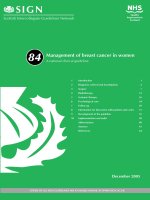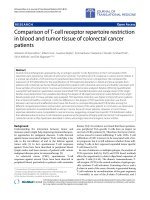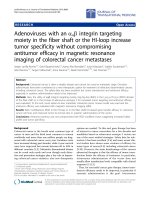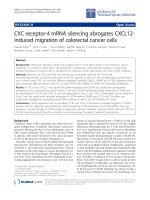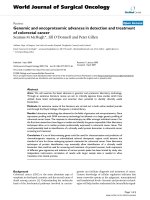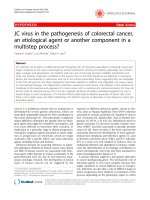Metabolic profiling of colorectal cancer
Bạn đang xem bản rút gọn của tài liệu. Xem và tải ngay bản đầy đủ của tài liệu tại đây (3 MB, 195 trang )
METABOLIC PROFILING OF
COLORECTAL CANCER
MAINAK MAL
(M.Pharm, Jadavpur University, India)
A THESIS SUBMITTED
FOR THE DEGREE OF DOCTOR OF
PHILOSOPHY
DEPARTMENT OF PHARMACY
NATIONAL UNIVERSITY OF SINGAPORE
2011
I
ACKNOWLEDGEMENTS
I would like to convey my sincere regards and gratitude to my supervisor
Assoc. Prof. Eric Chun Yong Chan, (Dept. of Pharmacy, National University
of Singapore) and co-supervisor Dr. Poh Koon Koh, (Deputy Director,
Colorectal Cancer Research Laboratory, Dept. of Colorectal Surgery,
Singapore General Hospital), for providing me an opportunity to work in this
challenging project and for their continuous support, encouragement and
invaluable guidance.
I would like to convey my appreciation to Assoc. Prof. Chan Sui Yung
(Head of the Dept. of Pharmacy, National University of Singapore) as well as
my PhD. thesis committee members, Assoc. Prof. Go Mei Lin (Deputy Head
of the Dept. of Pharmacy, National University of Singapore) and Asst. Prof.
Ho Han Kiat (Dept. of Pharmacy, National University of Singapore) for their
help, support and encouragement.
I would also like to extend my sincere thanks to Dr. Peh Yean Cheah,
Dr. Kong Weng Eu, Grace Wong and Elya at the Colorectal Cancer Research
Laboratory, Dept. of Colorectal Surgery, Singapore General Hospital, for their
help and support especially for collection of tissue samples and patient’s
metadata.
I would like to express my cordial thanks to Dr. Hector C Keun,
Alexandra Backshall, Rachel Cavill, Prof. Jeremy K Nicholson and Dr. Toby
Athersuch at the the Imperial College London, UK, for their help and support
in HR-MAS NMR spectroscopy based metabolic profiling of colorectal
cancer.
II
I would like to express my sincere gratitude and respect to my parents,
grandparents and other family members who have always encouraged me to
pursue higher studies, provided moral support and always stood by my side
during this crucial phase of my life and career.
I would also like to thank my fellow research group members, New
Lee Sun, Kishore K Pasikanti, Sudipta Saha, Tarang Nema, Chang Kai Lun,
Thiru Selvi, Chng Hui Ting, Yip Lian Yee and Phua Lee Cheng for their
valuable assistance and support.
Finally, I would like to express my sincere thanks to all my fellow
research scholars and friends, especially Animesh, Goutam, Pradipto, Sandip
and Tanay for providing the excellent camaraderie which was invaluable for
successful completion of my PhD. project.
III
TABLE OF CONTENTS
ACKNOWLEDGEMENTS
I
TABLE OF CONTENTS
III
SUMMARY
VIII
LIST OF ABBREVIATIONS
XI
LIST OF TABLES
XVI
LIST OF FIGURES
XVIII
CHAPTER 1. INTRODUCTION
1
1.1. Overview of colorectal cancer
1
1.1.1. Prevalence of colorectal cancer
1
1.1.2. Etiology of colorectal cancer
2
1.1.3. Pathways of colorectal cancer development
4
1.1.4. Diagnosis of colorectal cancer
5
1.1.5. Staging of colorectal cancer
6
1.1.6. Prognosis of colorectal cancer
7
1.1.7. Treatment of colorectal cancer
10
1.1.8. Inflammation and colorectal cancer
11
1.1.9. Challenges in the management of colorectal cancer
12
1.2. Metabolic profiling
13
1.2.1. Biomatrices used for metabolic profiling
15
1.2.2. Analytical platforms used for metabolic profiling
15
1.2.2.1. Nuclear magnetic resonance (NMR) spectroscopy
16
1.2.2.2. Mass spectrometry (MS) based techniques
17
1.2.2.3. LC/NMR/MS hybrid techniques
19
IV
1.2.2.4. Other analytical techniques
20
1.2.3. Chemometrics in metabolic profiling
21
1.2.4. Role of metabolic profiling in colorectal cancer
26
1.3. Study hypotheses
27
1.3.1. Hypothesis for non-targeted metabolic profiling of CRC
27
1.3.2. Hypothesis for targeted profiling of eicosanoids and
arachidonic acid in CRC
27
1.4. Study objectives
28
1.5. Significance of the study
28
CHAPTER 2. DEVELOPMENT AND VALIDATION OF A
GC/MS METHOD FOR NON-TARGETED METABOLIC
PROFILING OF HUMAN COLON TISSUE
30
2.1. Introduction
30
2.2. Experimental
31
2.2.1. Materials
31
2.2.2. Human colon tissue samples
32
2.2.3. Sample preparation
32
2.2.4. GC/MS analysis
35
2.2.5. Method validation
36
2.2.5.1. Freeze-thaw cycle and auto-sampler stability
36
2.2.5.2. Long-term stability
37
2.2.5.3. Intra- and inter-day precision
37
2.2.5.4. Selectivity
37
2.2.5.5. Linearity
38
V
2.2.5.6. Sensitivity
38
2.3. Results and discussion
39
2.4. Conclusion
48
CHAPTER 3. NON-TARGETED METABOLIC PROFILING OF
COLORECTAL CANCER USING GC/MS
49
3.1. Introduction
49
3.2. Experimental
49
3.2.1. Clinical population and tissue samples
49
3.2.2. GC/MS analysis
49
3.2.3. GC/MS data analysis
52
3.3. Results and discussion
54
3.4. Conclusion
61
CHAPTER 4. NON-TARGETED METABOLIC PROFILING OF
COLORECTAL CANCER USING HR-MAS NMR
SPECTROSCOPY
62
4.1. Introduction
62
4.2. Experimental
63
4.2.1. Clinical population and tissue samples
63
4.2.2. HR-MAS NMR spectroscopy analysis
65
4.2.3. HR-MAS NMR spectroscopy data analysis
67
4.2.3.1. HR-MAS NMR spectroscopy data analysis using
Matlab and manual identification of metabolites
67
4.2.3.2. HR-MAS NMR spectroscopy data analysis using
Chenomx NMR suite software
68
VI
4.3. Results and discussion
69
4.4. Conclusion
77
CHAPTER 5. NON-TARGETED METABOLIC PROFILING OF
COLORECTAL CANCER USING GC×GC/TOFMS
78
5.1. Introduction
78
5.2. Experimental
79
5.2.1. Clinical population and tissue samples
79
5.2.2. Validation of analytical performance of GC×GC/TOFMS
80
5.2.3. GC×GC/TOFMS analysis
81
5.2.4. GC×GC/TOFMS data analysis
82
5.3. Results and discussion
83
5.4. Conclusion
94
CHAPTER 6. DEVELOPMENT AND VALIDATION OF AN
UPLC/MS/MS METHOD FOR TARGETED PROFILING OF
EICOSANOIDS AND ARACHIDONIC ACID IN COLORECTAL
CANCER
98
6.1. Introduction
98
6.2. Experimental
100
6.2.1. Materials
100
6.2.2. Human colon tissue samples
101
6.2.3. Sample preparation
101
6.2.4. Protein assay
102
6.2.5. UPLC/MS/MS analysis
103
6.2.6. Method validation
104
VII
6.2.6.1. Selectivity
104
6.2.6.2. Sensitivity
106
6.2.6.3. Matrix effect
106
6.2.6.4. Linearity and accuracy
108
6.2.6.5. Intra- and inter-day precision
110
6.2.6.6. Autosampler stability
110
6.2.6.7. Extraction efficiency
111
6.3. Results and discussion
111
6.4. Conclusion
117
CHAPTER 7. TARGETED PROFILING OF EICOSANOIDS AND
ARACHIDONIC ACID IN COLORECTAL CANCER USING
UPLC/MS/MS
118
7.1. Introduction
118
7.2. Experimental
119
7.2.1. Clinical population and tissue samples
119
7.2.2. UPLC/MS/MS analysis
120
7.2.3. UPLC/MS/MS data analysis
121
7.3. Results and discussion
121
7.4. Conclusion
128
CHAPTER 8. CONCLUSION AND FUTURE DIRECTIONS
129
8.1. Conclusion
129
8.2. Future directions
132
REFERENCES
135
APPENDIX I: List of Publications
i
VIII
SUMMARY
Colorectal cancer (CRC) is the second most common form of cancer in the
world and the most common cancer in Singapore. The limitations of the
currently available methods and biomarkers for CRC management highlight
the necessity of finding novel markers. Alterations in different metabolic
pathways in CRC as indicated by proteomic studies, are likely to result in
changes in metabolic profile which if identified with the aid of metabolic
profiling can help in the identification of marker metabolites and can provide
molecular insight in CRC. Metabolic profiling is complementary to genomics
and proteomics as it measures the perturbed metabolic end-points due to
environmental, pharmacological or pathological influences while in genomics
and proteomics, more upstream biological events are typically profiled and
studied.
In this thesis, metabolic profiling of CRC was carried out with a non-
targeted as well as a targeted approach to identify metabolite-based markers.
For non-targeted metabolic profiling of CRC, three different analytical
platforms namely GC/MS, HR-MAS NMR spectroscopy and
GC×GC/TOFMS were explored. The data generated in conjunction with
chemometric analysis led to the identification of marker metabolites belonging
to diverse chemical classes. Although the orthogonal partial least squares
discriminant analysis (OPLS-DA) models generated on the basis of profiled
data using the three analytical platforms were capable of discriminating
normal tissues from malignant ones, no valid OPLS-DA model was obtained
using CRC stage as the classifier. This implied that the metabolic phenotype
IX
associated with CRC although distinct from that of normal tissue, it is not
sensitive enough to discriminate the different stages of CRC. Of the three
analytical methods used, only HR-MAS NMR spectroscopy-based metabolic
profiling was able to produce a valid OPLS-DA model capable of
discriminating anatomical site of tumor. The identified marker metabolites
when linked to metabolic pathways using KEGG database, revealed
perturbations of various biochemical processes the majority of which could be
attributed to the higher energy demand, tissue, hypoxia and altered synthetic
rate of cellular components of rapidly proliferating tumor cells. In addition to
this, altered eicosanoid biosynthetic pathway as indicated by reduced
arachidonic acid (AA) levels in CRC tissues and presence of comparatively
higher levels of picolinic acid in CRC tissues, implied an association of
inflammatory environment with CRC development.
A strong evidence of association between inflammation and CRC
exists. Moreover the significant role played by eicosanoids in inflammation, as
well as the altered expression of key enzymes involved in eicosanoid
biosynthesis in CRC, formed our objective to carry out targeted metabolic
profiling of 8 biologically relevant eicosanoids and the major metabolic
precursor AA. The main aim of this study was to record the fluctuations of
these inflammatory metabolites and to better understand their implicated roles
in inflammation mediated CRC carcinogenesis. An UPLC/MS/MS-based
method was developed and validated successfully for this purpose. The results
indicated deregulation of eicosanoid biosynthetic pathways and implied that a
complex interaction between pro-tumorigenic and antitumorigenic eicosanoids
is involved in inflammation-associated CRC carcinogenesis.
X
Metabolic profiling of CRC led to the identification of marker
metabolites and revealed metabolic perturbations that may be exploited for
future biomarker research or finding new therapeutic strategies.
XI
LIST OF ABBREVIATIONS
1D
One-dimensional
2D
Two-dimensional
5-FU
5-fluorouracil
6-k-PGF
1α
6-keto-prostaglandin
1α
8-HETE
8-hydroxy-5Z,9E,11Z,14Z-eicosatetraenoic acid
12-HETE
12-hydroxy-5Z,8Z,10E,14Z-eicosatetraenoic acid
13S-HODE
13S-hydroxy-9Z,11E-octadecadienoic acid
15-HETE
15-hydroxy eicosatetraenoic acid
15-PGDH
15-hydroxyprostaglandin dehydrogenase
AA
Arachidonic acid
ACN
Acetonitrile
AJCC
American Joint Committee on cancer
Akt
Serine/threonine protein kinase
APC
Adenomatous polyposis coli
ASR
Age-standardized rate
AUC
Area under the ROC curve
BAX
B-cell lymphoma-2 associated X protein
bcl-2
B-cell lymphoma 2
BHT
Butylated hydroxyl toluene
BSA
Bovine serum albumin
BSTFA
N, O-bis (trimethylsilyl) trifluoroacetamide
CA 19-9
Carbohydrate antigen 19-9
CAD
Collision-activated dissociation
CD
Crohn’s disease
CE
Capillary electrophoresis
CE/MS
Capillary electrophoresis mass spectrometry
ChoCC
Choline-containing compounds
CIN
Chromosomal instability
CIRB
Centralised Institutional Review Board
COSY
Correlation spectroscopy
COX
Cyclooxygenase
XII
CPMG
Carr-Purcell-Meiboom-Gill
CRC
Colorectal cancer
CSI
Chemical shape indicator
CT
Computed tomographic
D
2
O
Deuterium oxide
DCBE
Double contrast barium enema
DCC
Deleted in colorectal cancer
DModX
Distance to model plot
EGF
Epidermal growth factor
EI
Electron impact
EIA
Enzyme immunoassay
ESI
Electrospray ionization
FA
Formic acid
FAP
Familial adenomatous polyposis coli
FOBT
Faecal occult blood test
FTIR
Fourier transform infrared
GC×GC/TOFMS
Two dimensional gas chromatography time of flight
mass spectrometry
GC/MS
Gas chromatography mass spectrometry
GC/MS/MS
Gas chromatography tandem mass spectrometry
GC/TOFMS
Gas chromatography time of flight mass spectrometry
HETEs
Hydroxy eicosatetraenoic acids
HMDB
Human Metabolome database
HMG-CoA
3-hydroxy-3-methyl-glutaryl-Coenzyme A
HNPCC
Hereditary nonpolyposis colorectal cancer
HPLC
High performance liquid chromatography
HR-MAS NMR
High resolution magic angle spinning NMR
Hz
Hertz
IBD
Inflammatory bowel disease
ICH
International Conference on Harmonization
i.d.
Internal diameter
IGFR2
Immunoglobulin G Fc Receptor II
XIII
IL-6
Interleukin-6
IRB
Institutional review board
IS
Internal standard
JRES
J-resolved
KEGG
Kyoto Encyclopedia of Genes and Genomes
KRAS
V-Ki-ras2 Kirsten rat sarcoma viral oncogene homolog
LC
Liquid chromatography
LC/MS
Liquid chromatography mass spectrometry
LC/MS/MS
Liquid chromatography tandem mass spectrometry
LOD
Limit of detection
LOQ
Limit of quantification
LOX
Lipoxygenase
LTB
4
Leukotriene B
4
LTs
Leukotrienes
LV
Leucovorin
LVs
Latent variables
MAC
Modified Astler Coller
min
Minute
MMR
Mismatch repair
MOX
Methoxyamine hydrochloride in pyridine
MRI
Magnetic resonance imaging
MRM
Multiple reaction monitoring
MS
Mass spectrometry
MSI
Microsatellite instability
MSTFA
N-methyl-N-trifluoroacetamide
m/z
Mass is to charge ratio
NF-ĸB
Nuclear factor kappa B
NIST
National Institute of Standards and Technology
NMR
Nuclear magnetic resonance
NOESY
Nuclear Overhauser effect spectroscopy
NSAIDs
Non-steroidal anti-inflammatory drugs
OPLS
Orthogonal partial least squares
XIV
OPLS-DA
Orthogonal partial least squares discriminant analysis
p53
Protein 53
PBS
Phosphate buffer saline
PC
Phosphocholine
PCA
Principal component analysis
PCs
Principal components
PE
Phosphoethanolamine
PGD
2
Prostaglandin D
2
PGE
2
Prostaglandin E
2
PGE
2
-d
4
Deuterated prostaglandin E
2
PGF
2α
Prostaglandin F
2α
PGI
2
Prostacyclin
PGs
Prostaglandins
PHGDH
Phosphoglycerate dehydrogenase
PI3K
Phosphatidyl-inositol-3-kinase
PLS
Partial least squares
PLS-DA
Partial least squares discriminant analysis
PPARδ
Peroxisome proliferator activated receptor-δ
ppm
Parts per million
QC
Quality control
r
2
Correlation coefficient
RAS-MAPK
Rat sarcoma viral oncogene-mitogen activated protein
kinase
RD
Recycle delay
RIA
Radioimmunoassay
ROC
Receiver operating characteristic
rpm
Revolutions per minute
RSD
Relative standard deviation
R
t
Retention time
s
Second
SD
Standard deviation
s/n
Signal-to-noise ratio
XV
SGH
Singapore General Hospital
SI
Similarity index
TCA
Tricarboxylic acid
TGF-α
Tumor growth factor alpha
TGFBR2
Transforming growth factor-beta receptor II gene
TMCS
Trimethylchlorosilane
TNF-α
Tumor necrosis factor-alpha
TNM
Tumor, node, metastases
TOCSY
Total correlation spectroscopy
TS
Thymidylate synthase
TXA
2
Thromboxane A
2
TXB
2
Thromboxane B
2
TXs
Thromboxanes
UPLC/MS/MS
Ultra performance liquid chromatography tandem mass
spectrometry
US-FDA
United States Food and Drug Administration
UV
Unit variance
V
Volt
VEGF
Vascular endothelial growth factor
WHO
World Health Organization
YSR
Year survival rate
XVI
LIST OF TABLES
Table 1.1.
TNM system and AJCC stage groupings with equivalent
Dukes and MAC stages of CRC.
9
Table 1.2.
Advantages, disadvantages and applications of different
analytical platforms used for metabolic profiling.
22
Table 2.1.
Endogenous metabolites and results of stability and
precision studies.
44
Table 2.2.
Results of linearity of response of 19 selected standard
metabolites (spiked before extraction and then taken
through the entire sample preparation process).
47
Table 3.1.
Summary of anatomical and clinicopathological
characteristics of the clinical tissue samples analyzed by
GC/MS.
51
Table 3.2.
Marker metabolites identified by GC/MS.
57
Table 4.1.
Summary of anatomical and clinicopathological
characteristics of the clinical tissue samples analyzed by
HR-MAS NMR spectroscopy.
64
Table 4.2.
Marker metabolites identified by HR-MAS NMR
spectroscopy (data processed by Matlab with manual
metabolite assignment).
72
Table 4.3.
Marker metabolites identified by HR-MAS NMR
spectroscopy (data processed by Chenomx NMR suite).
73
Table 5.1.
Marker metabolites identified by GC×GC/TOFMS.
87
Table 5.2.
Comparison of different analytical platforms used for
non-targeted metabolic profiling of CRC.
95
Table 5.3.
Metabolites, metabolic pathways and biological relevance
in colorectal cancer.
96
Table 6.1.
Optimized source- and compound-dependent MS
parameters.
105
Table 6.2.
Optimized UPLC elution conditions.
105
Table 6.3.
Linearity, LOD and LOQ of eicosanoids and AA.
115
Table 6.4.
Validation of assay precision and autosampler stability of
metabolites.
116
XVII
Table 6.5.
Extraction efficiency of eicosanoids and AA.
116
Table 7.1.
Summary of clinicopathological characteristics of CRC
patients.
123
Table 7.2.
Endogenous levels of eicosanoids and AA in 36 pairs of
CRC and normal tissues.
125
XVIII
LIST OF FIGURES
Figure 2.1.
GC/MS chromatograms depicting results of development
and optimization of sample preparation method. A: No
appreciable difference observed between different
extraction strategies. [Sonication for 100 min opted for
ease of sample preparation]; B: Effect of different tissue
weights on GC/MS profile [20 mg chosen as minimal
weight for tissue]; C: Effect of different derivatization
strategies [MOX effecting resolution as compared to
MSTFA alone].
33
Figure 2.2.
Representative GC/MS chromatogram of normal human
colon tissue. The numbering of metabolite peaks
corresponds to peak number of metabolites as shown in
Table 2.1. Metabolites are also classified according to
their chemical classes.
43
Figure 3.1.
GC/MS chromatogram overlay of CRC and normal
tissues depicting the marker metabolite peaks.
56
Figure 3.2.
PCA plot of CRC and normal tissues based on GC/MS
metabolic profiles.
58
Figure 3.3.
OPLS-DA scores plot discriminating CRC from normal
mucosae based on GC/MS metabolic profiles.
58
Figure 3.4.
ROC curve determined using the cross-validated
predicted Y values of the GC/MS OPLS-DA model.
59
Figure 4.1.
HR-MAS NMR spectra of representative CRC and
normal tissue.
71
Figure 4.2.
OPLS-DA scores plot discriminating CRC from normal
tissues based on selected marker metabolites detected by
HR-MAS NMR (data processed by Matlab with manual
metabolite assignment).
74
Figure 4.3.
ROC curve determined using the cross-validated
predicted Y-values of the HR-MAS NMR OPLS-DA
model (data processed by Matlab with manual metabolite
assignment).
74
Figure 4.4.
OPLS-DA scores plot discriminating CRC from normal
tissues based on marker metabolites detected by HR-
MAS NMR (data processed by Chenomx NMR suite).
75
Figure 4.5.
ROC curve determined using the cross-validated
predicted Y-values of the HR-MAS NMR OPLS-DA
75
XIX
model (data processed by Chenomx NMR suite).
Figure 4.6.
OPLS-DA scores plot discriminating colon from rectal
cancers based on HR-MAS NMR data (processed by
Matlab with manual metabolite assignment).
76
Figure 4.7.
ROC curve determined using the cross-validated
predicted Y-values of the HR-MAS NMR OPLS-DA
model with anatomical site as classifier.
76
Figure 5.1.
A. Surface plot of GC×GC/TOFMS chromatogram of
human colon tissue.
B. Contour plot of GC×GC/TOFMS chromatogram of
human colon tissue (black dots indicate peaks).
84
Figure 5.2.
PCA plot of CRC and normal tissues along with QC
samples based on GC×GC/TOFMS metabolic profiles.
85
Figure 5.3.
OPLS-DA scores plot discriminating CRC from normal
tissues based on GC×GC/TOFMS metabolic profiles.
85
Figure 5.4.
ROC curve determined using the cross-validated
predicted Y values of the GC×GC/TOFMS OPLS-DA
model.
86
Figure 6.1.
Representative UPLC/MS/MS chromatogram of a sample
comprising all the standard metabolites.
114
Figure 6.2.
Matrix effect on profiled metabolites (represented by
mean percentage ion suppression with error bars
depicting standard deviation).
115
Figure 7.1.
Pathways for Arachidonic acid metabolism.
122
Figure 7.2.
Endogenous levels of eicosanoids and AA in 36 pairs of
CRC and normal tissues.
125
1
CHAPTER 1
INTRODUCTION
1.1. Overview of colorectal cancer
In this section an overview of different aspects of colorectal cancer (CRC)
such as prevalence, etiology, pathways of CRC development, diagnosis,
staging, prognosis, treatment, relation between inflammation and CRC and
current challenges in CRC management is presented.
1.1.1. Prevalence of colorectal cancer
Worldwide statistics indicate that CRC is the third most common cancer in
men (663000 cases, 10.0% of the total) and the second in women (571000
cases, 9.4% of the total) (Ferlay et al., 2008). Incidence rates are considerably
prominent in men than in women [overall sex ratio of the age-standardized
rate (ASR) is 1.4:1]. According to the World Health Organization (WHO), the
ASR for incidence of CRC is greater than 49.4 per 100,000 per year, in
regions such as North America, Europe, Japan, Israel, Singapore, Australia
and New Zealand. In addition to this, CRC is relatively prevalent in some
areas of Brazil, Argentina, Hong Kong, Southern China and Malaysia (ASR
for incidence of CRC greater than 25.3 per 100,000 per year)
(, Rozen et al., 2006). In Singapore, CRC is the leading
cancer in males and the second most common cancer in females, accounting
for 17.9% of all cancers in males and 14.4% in females. When both genders
2
are combined, CRC is the most common cancer in Singapore. In the world,
around 608000 deaths occur from CRC, constituting for 8% of all cancer
deaths, making it the fourth most common cause of death from cancer. As
observed for incidence, mortality rates are lower in women than in men,
except in the Caribbean. There is less variability in mortality rates worldwide
(6-fold in men, 5-fold in women), with the highest mortality rates in both
sexes estimated in Central and Eastern Europe (20.1 per 100,000 for male,
12.2 per 100,000 for female), and the lowest in Middle Africa (3.5 and 2.7
respectively). Almost 60% of the cases occur in developed regions (Ferlay et
al., 2008). The ASR for mortality from CRC in Singapore over the period
from 2002 to 2006 was 18.1 per 100,000 per year in males and 12.5 in females
(Tey et al., 2008). The ASR for CRC mortality rates in the United States and
United Kingdom in 2002 according to the WHO were 14.8 and 17.3 per
100,000 per year, respectively (). Certainly CRC has
emerged as a serious threat to public health both in Singapore as well as
overseas.
1.1.2. Etiology of colorectal cancer
On the basis of etiology, CRC can be inheritable, inflammatory or sporadic in
nature. Lynch syndrome is the most common hereditary syndrome that
predisposes patients to CRC, followed by familial adenomatous polyposis coli
(FAP). Although the terms Lynch syndrome and hereditary nonpolyposis
colorectal cancer (HNPCC) are often used synonymously, HNPCC
specifically refers to those disorders that have similar phenotypes but lack the
3
specific mutations involved in Lynch syndrome. Lynch syndrome and HNPCC
together account for 2-5% of all CRC. This form of heritable CRC is
characterized by early onset and predominantly right-sided mucinous tumor.
Germline mutations in the mismatch repair (MMR) genes namely MLH1 and
MSH2 characterized by replication error and hence DNA or microsatellite
instability (MSI), comprises the major genetic defect causing HNPCC or
Lynch syndrome. Apart from CRC, HNPCC or Lynch syndrome also
predisposes patients to other extra-colonic cancers such as small-intestine,
renal pelvis and endometrial cancer (Lindor et al., 2005; Lynch et al., 2009).
FAP which is responsible for less than 1% of all CRC cases occurs due to a
mutation in the adenomatous polyposis coli (APC) gene. Development of
hundreds to thousands of adenomatous polyps in the colon and rectum of
individuals starting from early adolescence, which inevitably leads to CRC if
untreated, is the main characteristic of FAP. FAP also leads to various extra-
colonic manifestations like thyroid cancer, duodenal and fundic gland
polyposis and desmoids (Jasperson et al., 2010). Inflammatory bowel disease
(IBD) including Crohn’s disease (CD) and ulcerative colitis may also lead to
CRC. However patients with IBD represent only 1-2% of CRC cases. The risk
of CRC is much higher in individuals having prolonged (more than 30 years)
and extensive ulcerative colitis (Lakatos and Lakatos, 2008; Kraus and Arber,
2009). Majority of CRC (up to 80%) is sporadic in nature with no well defined
etiology and occurs due to interaction between genetic and environmental
factors (Cheah, 1990). Ageing is one of the major risk factors for sporadic
CRC as 99% of cases occur in people more than 40 years of age and 85% in
those more than 60 years of age. Higher incidence of CRC in affluent societies
4
is related to lifestyle related factors such as high intake of fat and red meat,
insufficient intake of fiber rich food and vegetables, obesity and low physical
activity. High alcohol consumption, diabetes mellitus and smoking also
increase the risk of CRC (Ballinger and Anggiansah, 2007; Cunningham et al.,
2010).
1.1.3. Pathways of colorectal cancer development
CRC develops because of genetic abnormalities most of which are caused by
environmental and lifestyle related factors while some are inherited. The two
major genetic pathways of CRC development are the chromosomal instability
(CIN) pathway and the microsatellite instability (MSI) pathway. In most cases
CRC develops by the CIN pathway which is characterized by aneuploidy. The
most frequent genetic abnormality consists of mutations in the V-Ki-ras2
Kirsten rat sarcoma viral oncogene homolog (KRAS) and APC genes.
Inherited mutations in the APC gene results in FAP whereas allelic loss of
chromosome 5 (site of the APC gene) causes APC changes in sporadic CRC.
Loss of function of the protein 53 (p53) is a crucial event related to the
transformation of adenoma to carcinoma (Powell et al., 1992; Stoler et al.,
1999; Vogelstein et al., 1988). The MSI pathway is characterized by the
dysfunction of MMR gene. Such mutations may be inherited resulting in
HNPCC or Lynch syndrome or may result from acquired epigenetic events.
Genes which are more susceptible to mutations in this pathway include
transforming growth factor-beta receptor II (TGFBR2) gene, B-cell
lymphoma-2 (bcl-2) associated X protein (BAX) gene (essential for apoptosis)
5
and Immunoglobulin G Fc Receptor II (IGFR2) gene (essential for
differentiation) (Grady, 2004). Apart from the CIN and the MSI pathways,
CRC can also develop through the serrated adenoma pathway. This pathway is
characterized by the absence of MSI and widespread methylation of genes
SLC5A8, p16 and MGMT (Dong et al., 2005; Jass, 1999).
1.1.4. Diagnosis of colorectal cancer
CRC if diagnosed at an early stage improves the chances of survival of
patients and reduces treatment-related morbidity. An individual may be
diagnosed with CRC when he or she presents certain symptoms or as a result
of any screening program. Usually the early stage CRC does not produce any
detectable symptoms. Moreover, most of the symptoms of CRC such as
change in bowel habits, blood in stool, general discomfort in the abdomen,
weight loss and tiredness, lack specificity. Therefore it is essential to carry out
regular screening programs to detect CRC. Endoscopy using either flexible
sigmoidoscopy or colonoscopy with tumour biopsy is the most common
diagnostic method for CRC. However, these techniques require extensive
bowel preparation and lacks patient compliance due to their invasive nature.
Double contrast barium enema (DCBE) is used as an adjunct diagnostic
technique especially to detect tumours or polyps in tortuous anatomical sites
where endoscopic study is difficult to carry out. Although faecal occult blood
test (FOBT) for CRC diagnosis is simple and non invasive in nature, it lacks
specificity. Faecal DNA based test is more sensitive than FOBT but it is
tedious to administer and expensive. Computed tomographic (CT)
